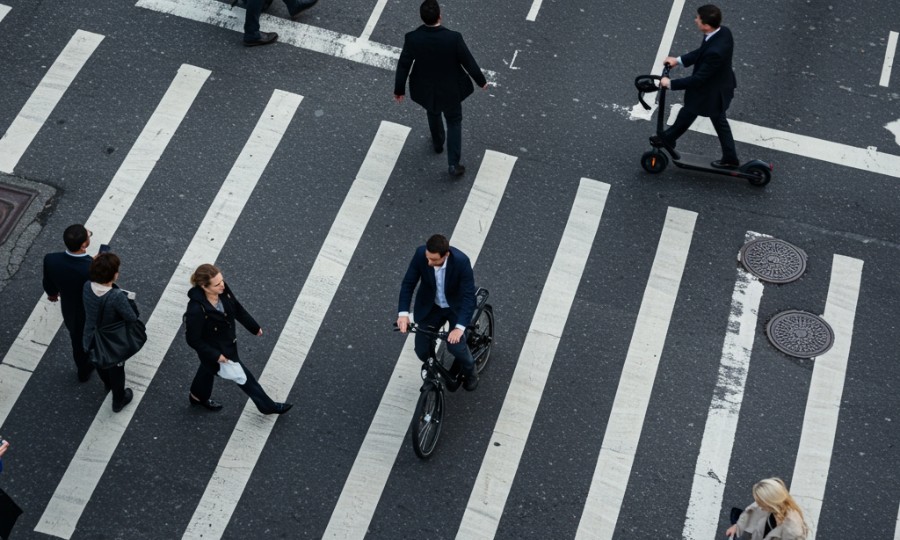
Have you ever found yourself navigating a bustling New York City street, only to be startled by the silent rush of an e-bike or e-scooter zipping past? It’s a common experience for many New Yorkers, and it highlights a growing tension in our urban landscape: the delicate balance between the convenience of micromobility and the critical need for pedestrian safety. We’re seeing more and more e-bikes and scooters on our streets, which is fantastic for quick commutes and reducing traffic, but it also sparks a lively debate about the risks, especially for those of us on foot.
This isn’t just a casual observation; it’s a significant public safety concern that city officials, advocacy groups, and everyday citizens are grappling with. The numbers, though sometimes debated, suggest an undeniable increase in incidents. So, what’s really going on here? And what’s NYC doing about it?
The Rise of Micromobility: A Double-Edged Sword in NYC
The explosion of e-bikes and e-scooters in New York City has been nothing short of transformative. For many, especially delivery workers, these devices are essential tools, providing an efficient and often more affordable way to get around our sprawling metropolis. For commuters, they offer a quick, environmentally friendlier alternative to crowded subways or gridlocked buses. You can’t deny their appeal – they’re quick, they’re often fun, and they represent a shift towards more sustainable urban transportation.
Here’s the thing, though: this rapid integration hasn’t been without its growing pains. While e-bikes and scooters offer incredible flexibility, their speed, silent operation, and sometimes unpredictable user behavior present real challenges. We’ve all witnessed riders weaving through traffic, ignoring red lights, or, more concerningly, riding on sidewalks. These actions, unfortunately, can put pedestrians in precarious situations, leading to avoidable accidents and injuries. You might wonder, ‘Are these devices making our streets more dangerous for walkers?’ It’s a valid question, and one that city agencies like the NYC Department of Transportation (DOT) and Vision Zero are continually trying to answer with data, policy, and infrastructure improvements.
Navigating the Data: What Are the Real Risks to Pedestrians?
When we talk about pedestrian accidents involving micromobility, it can feel like everyone has a strong opinion, but what do the numbers actually tell us? The truth is, gathering precise data on e-bike and e-scooter incidents can be complex. Different agencies collect information in varying ways, and the sheer volume of these devices makes comprehensive tracking a monumental task. However, aggregated reports from the NYPD and public health initiatives often paint a concerning picture. We’re seeing an uptick in emergency room visits related to e-bike and scooter collisions, with pedestrians frequently being the victims.
Think about a typical scenario: a pedestrian stepping off a curb, assuming the coast is clear, only for a fast-moving e-scooter to appear silently from around a corner. Or a delivery e-bike, rushing to meet a deadline, making a sudden turn without signaling. These aren’t isolated incidents; they’re common occurrences that contribute to a collective sense of unease. While many riders are responsible, the actions of a few can unfortunately cast a shadow over the entire micromobility movement. It’s not about villainizing riders, but acknowledging the need for safer practices and clear guidelines to protect everyone, especially vulnerable pedestrians. After all, shouldn’t everyone feel safe walking down the street?
NYC’s Regulatory Balancing Act: Current Laws and Enforcement
New York City isn’t just sitting by; it’s actively trying to manage this evolving landscape through legislation and enforcement. The city has enacted several important measures aimed at improving e-bike safety in NYC and regulating micromobility to protect pedestrians. For instance, e-bikes and scooters are generally prohibited from operating on sidewalks, and there are specific speed limits they must adhere to on streets and in bike lanes. Helmets are required for riders under 14, and for all commercial e-bike operators. (Though, let’s be honest, you don’t always see those rules being followed perfectly.)
Enforcement, primarily handled by the NYPD, has ramped up in recent years, with campaigns targeting illegal sidewalk riding and unregistered mopeds. We’ve seen significant efforts to educate riders about the rules of the road, and there have been pushes to ensure that delivery platforms are also playing their part in promoting compliance among their workers. But it’s a constant challenge. With so many devices and so much ground to cover, consistent enforcement of NYC e-bike laws can feel like a game of whack-a-mole. The city is essentially trying to thread a very fine needle: encouraging sustainable transportation while simultaneously safeguarding its millions of pedestrians. It’s a tough job, and it requires continuous adaptation and community buy-in.
Beyond Regulation: Fostering a Culture of Shared Streets
While laws and enforcement are crucial, they’re only part of the solution to the urban micromobility challenges we face. Truly addressing the debate around e-bikes and scooters and their impact on pedestrian safety requires a multi-faceted approach that goes beyond just penalties. We need to foster a culture of shared responsibility and respect among all road users. This means better infrastructure, comprehensive education, and a collective commitment to safety.
First, let’s look at infrastructure. Dedicated, protected bike lanes are a game-changer. When e-bikes and scooters have their own clear, safe space, they’re less likely to be on sidewalks or in heavy traffic, which reduces conflict points with pedestrians and cars. Then, there’s education. It’s not just about telling riders what they can’t do; it’s about teaching everyone – drivers, cyclists, e-micromobility users, and pedestrians – how to safely coexist. This could involve public awareness campaigns that emphasize yielding, signaling, and simply paying attention. You might be thinking, ‘That sounds great, but will it actually work?’ I believe that by creating safer environments and empowering individuals with knowledge, we can significantly mitigate risks. It acknowledges that everyone has a role to play in making our streets safer, reducing the frustration and worry that many New Yorkers feel.
Moving Forward: A Collaborative Path to Safer NYC Streets
The ongoing debate around micromobility and pedestrian safety in New York City isn’t going away anytime soon. E-bikes and scooters are here to stay, and their benefits are too significant to ignore. What’s clear is that finding a sustainable path forward demands continuous dialogue, data-driven decisions, and a collaborative spirit from all stakeholders. We can’t simply wish these innovations away, nor can we ignore the legitimate concerns of pedestrians. It’s about finding that sweet spot where convenience meets caution.
So, what can you do? Stay informed about local regulations, advocate for better infrastructure in your neighborhood, and practice respectful road etiquette whether you’re walking, riding, or driving. By working together, we can ensure that New York City remains a vibrant, accessible, and, most importantly, safe place for everyone to navigate. The goal, ultimately, is a city where the thrill of urban mobility doesn’t come at the expense of anyone’s well-being. It’s a big challenge, but with collective effort, it’s one we can definitely tackle.
Free Case Consultation
Injured in an accident? Contact Rosenberg, Minc, Falkoff & Wolff for a free and confidential case review with an experienced NYC personal injury attorney.


